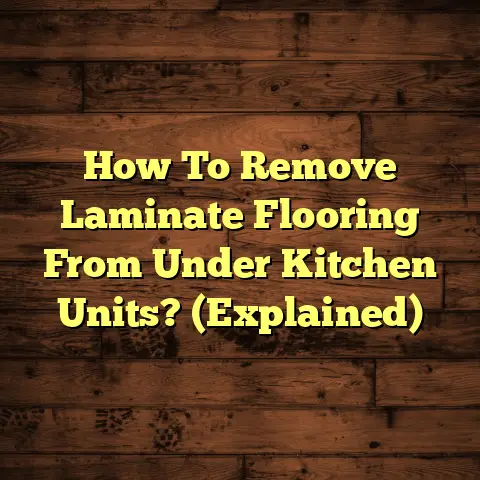Polishing Natural Stone Floors? (4 Steps To Shine!)
Have you ever walked into a room and felt instantly drawn to the floor?
I’m talking about those stunning natural stone floors that just radiate elegance and history.
Think of a grand foyer with marble floors that seem to whisper stories of generations past.
Or imagine a cozy kitchen where the limestone tiles have witnessed countless family meals and laughter.
These aren’t just floors; they’re canvases that hold memories, connect us to the earth, and reflect our commitment to beauty.
I can still remember one of my first jobs, polishing a slate floor in an old Victorian home.
The homeowner, Mrs. Gable, told me how her grandparents had installed it.
Seeing the floor gleam again, bringing back those memories for her, that’s what makes this work so rewarding.
In this article, I’m going to walk you through the process of polishing your natural stone floors.
I’ll share my expert tips and tricks so you can bring back that original shine and keep your floors looking pristine for years to come.
Ready to get started?
Section 1: Understanding Natural Stone Floors
Before we dive into polishing, let’s talk about the different types of natural stone floors you might have.
Each stone has its unique personality, benefits, and aesthetic appeal.
Think of it like this: each type of stone brings something special to the party.
-
Marble: Oh, marble. It’s the king of elegance, right? It’s known for its luxurious look and intricate veining. Marble floors can transform any space into a high-end masterpiece.
-
Granite: Granite is like the dependable friend who’s always there for you. It’s incredibly durable and resistant to stains and scratches. Perfect for high-traffic areas like kitchens and entryways.
-
Limestone: Limestone has a more relaxed, earthy vibe. It’s got a natural, understated beauty that can make any room feel warm and inviting.
-
Slate: Slate is rugged and unique, with its layered appearance and natural texture. It’s a great choice for adding character and a touch of the outdoors to your home.
-
Travertine: With its distinctive pitted surface, travertine offers a rustic, old-world charm. It’s often used in bathrooms and patios, bringing a touch of Mediterranean elegance.
Why is understanding your stone type so important?
Well, each type requires different care.
Marble, for example, is more porous and prone to staining than granite.
So, you’ll need to use different cleaning and polishing techniques for each.
Trust me, knowing your stone is half the battle!
Section 2: The Importance of Polishing Natural Stone Floors
Now, you might be thinking, “Why bother polishing?”
I get it. It sounds like a lot of work.
But let me tell you, polishing is crucial for the longevity and beauty of your natural stone floors.
Think about what your floors go through every day.
Foot traffic, spills, dirt, and just the natural aging process can take a toll.
Over time, the surface of the stone can become dull, scratched, and stained.
Polishing helps to:
-
Restore the Shine: Polishing brings back that original luster, making your floors look brand new.
-
Enhance the Color: It can deepen and enrich the natural colors of the stone, making them more vibrant.
-
Protect from Damage: Polishing seals the surface, making it more resistant to stains and scratches.
But how does it work?
At a microscopic level, polishing smooths out the tiny imperfections on the surface of the stone.
It’s like exfoliating your skin, but for your floors!
This creates a smoother, more reflective surface, which is what gives it that beautiful shine.
Plus, a polished surface is less porous, meaning it’s less likely to absorb spills and stains.
According to the National Stone Institute, regular polishing can extend the life of your stone floors by up to 25 years.
That’s a significant investment in your home’s beauty and value!
Section 3: Preparation for Polishing
Okay, so you’re convinced that polishing is a good idea. Great!
But before you start, you need to get prepared.
Trust me, proper preparation is key to a successful polishing job.
1. Gathering Supplies
First, let’s gather your supplies. Here’s what you’ll need:
-
Polishing Pads: You’ll need a set of diamond polishing pads in varying grits. I usually start with a coarser grit (like 400) and work my way up to a finer grit (like 3000).
-
Polishing Compound: Choose a polishing compound specifically designed for your type of stone. I recommend using a pH-neutral formula to avoid damaging the stone.
-
Floor Polishing Machine: You can rent one from most hardware stores. Make sure it’s designed for natural stone.
-
Wet/Dry Vacuum: This is essential for cleaning up the slurry (the mixture of water and polishing compound) as you go.
-
Mop and Buckets: For cleaning the floor before and after polishing.
-
pH-Neutral Cleaner: Use a cleaner specifically designed for natural stone.
-
Protective Gear: Wear safety glasses, gloves, and a dust mask to protect yourself from dust and splashes.
2. Preparing the Space
Next, clear the area of all furniture and debris.
This is crucial for a safe and efficient working environment.
You don’t want to be tripping over chairs or knocking over lamps while you’re trying to polish!
Cover any nearby walls or trim with plastic sheeting to protect them from splashes.
3. Cleaning the Floor
Now, it’s time to give your floor a thorough cleaning.
This is arguably the most important step.
Any dirt or grime left on the floor will interfere with the polishing process and can even scratch the stone.
Here’s how to do it:
-
Sweep or vacuum the floor to remove any loose dirt and debris.
-
Mop the floor with a pH-neutral cleaner and warm water.
-
Rinse the floor with clean water to remove any soap residue.
-
Let the floor dry completely before moving on to the next step.
4. Assessing the Condition of the Stone
Before you start polishing, take a close look at your stone floor.
Are there any cracks, chips, or deep stains that need to be addressed?
If so, you may need to repair them before polishing.
For minor chips and cracks, you can use a stone repair kit.
For deep stains, you may need to use a poultice to draw out the stain.
If you’re not comfortable making these repairs yourself, I recommend hiring a professional.
Section 4: The Four Steps to Shine
Alright, now for the fun part!
Here are the four steps to polishing your natural stone floors and bringing back that beautiful shine.
1. Step 1: Choosing the Right Polishing Method
There are several different methods of polishing natural stone floors, each with its own advantages and disadvantages.
The most common methods are:
-
Grinding: This is the most aggressive method, used to remove deep scratches and imperfections. It involves using a coarse diamond grinding pad to remove a thin layer of the stone.
-
Honing: This method is less aggressive than grinding and is used to create a smooth, matte finish. It involves using a series of progressively finer diamond honing pads.
-
Polishing: This is the final step, used to bring out the shine and luster of the stone. It involves using a fine diamond polishing pad and a polishing compound.
-
Buffing: This is a very gentle method used to enhance the shine of already polished stone. It involves using a soft buffing pad and a polishing compound.
So, how do you choose the right method?
It depends on the type of stone you have and the desired finish.
For example, if you have marble floors with deep scratches, you’ll need to start with grinding to remove the scratches.
Then, you’ll move on to honing and polishing to achieve a high-gloss finish.
If you have limestone floors with a few minor scratches, you may be able to skip the grinding and go straight to honing and polishing.
If your floors are already in good condition and you just want to enhance the shine, you can use buffing.
2. Step 2: Applying the Polishing Compound
Once you’ve chosen your polishing method, it’s time to apply the polishing compound.
The polishing compound is a crucial ingredient in the polishing process.
It contains abrasive particles that help to smooth out the surface of the stone and bring out the shine.
When selecting a polishing compound, look for one that is specifically designed for your type of stone.
I always recommend using a pH-neutral formula to avoid damaging the stone.
Here’s how to apply the polishing compound:
-
Pour a small amount of polishing compound onto the floor.
-
Use a clean cloth or sponge to spread the compound evenly over the surface.
-
Work in small sections to ensure that the compound is evenly distributed.
-
Avoid applying too much compound as this can make it difficult to polish and can leave streaks or an uneven shine.
3. Step 3: Using the Polishing Machine
Now, it’s time to break out the polishing machine.
This is where the magic happens!
Here’s how to use a polishing machine effectively:
-
Attach the appropriate polishing pad to the machine. Start with the coarsest grit pad for grinding, and then work your way up to the finer grit pads for honing and polishing.
-
Turn on the machine and adjust the speed to the recommended setting.
-
Work in small sections, overlapping each pass by about 50%.
-
Keep the machine moving at a steady pace to avoid creating swirl marks.
-
Apply even pressure to the machine, but don’t press down too hard.
-
Use a wet/dry vacuum to clean up the slurry as you go.
-
Repeat the process with each grit of polishing pad, until you achieve the desired shine.
Here are a few safety tips to keep in mind:
-
Wear safety glasses to protect your eyes from splashes.
-
Wear gloves to protect your hands from the polishing compound.
-
Wear a dust mask to protect your lungs from dust.
-
Keep the area well-ventilated to avoid inhaling fumes.
-
Be careful not to trip over the power cord.
4. Step 4: Finishing Touches and Maintenance
Once you’ve finished polishing, it’s time for the finishing touches.
First, use a clean mop and water to remove any remaining polishing compound from the floor.
Then, dry the floor with a clean towel.
Next, you may want to consider applying a sealant to protect the shine and prevent stains.
A sealant will create a barrier that will help to repel water and oil, making it easier to clean up spills.
When selecting a sealant, look for one that is specifically designed for your type of stone.
Here are a few maintenance tips to help you keep your natural stone floors looking pristine long after the initial polish:
-
Sweep or vacuum the floor regularly to remove loose dirt and debris.
-
Mop the floor with a pH-neutral cleaner and warm water.
-
Avoid using harsh chemicals or abrasive cleaners, as these can damage the stone.
-
Clean up spills immediately to prevent stains.
-
Place mats at entrances to trap dirt and moisture.
-
Consider having your floors professionally polished every few years to maintain their shine.
Conclusion: The Lasting Beauty of Polished Natural Stone Floors
So, there you have it!
Polishing natural stone floors might seem like a daunting task, but with the right tools and techniques, it’s definitely achievable.
And trust me, the results are worth it.
There’s nothing quite like the feeling of walking into a room and seeing your natural stone floors gleaming with a beautiful, natural shine.
It not only enhances the beauty of your home but also preserves cherished memories and adds to the overall value of your property.
Remember Mrs. Gable and her slate floor?
The shine wasn’t just about aesthetics; it was about rekindling a connection to her family history.
I encourage you to take pride in your natural stone flooring and celebrate the connection you have with it.
A little care can go a long way in maintaining its shine and allure for years to come.
So, grab your supplies, follow these steps, and get ready to transform your floors into a stunning centerpiece of your home.
Happy polishing!





